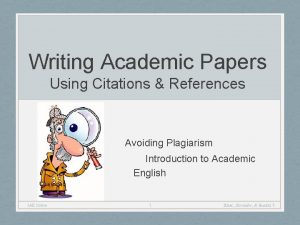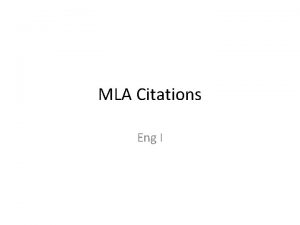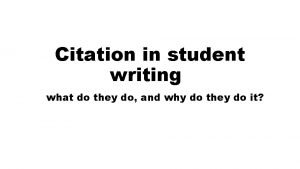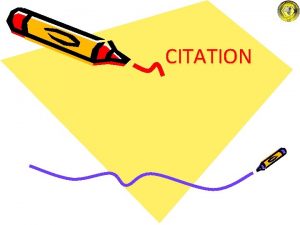QUOTES AND CITATION What is a Citation When









- Slides: 9

QUOTES AND CITATION

What is a Citation? When you bring research (quotations, paraphrases, facts, statistics, etc. ) into your paper, you must give credit to the source and its author(s). Giving credit to a source is also called citing a source. You do this with in-text or parenthetical citations. They are called parenthetical citations because the bibliographic information goes inside parentheses.

What to Cite Quotations: Someone else’s exact words, enclosed in quotation marks. The ideas, opinions, and theories of someone else—even if you restate them in your own words in a paraphrase or summary. Facts and statistics—unless they are common knowledge and are accessible in many sources.

Common Knowledge is information that can be found in many sources and that no one can claim owning. It is information that “belongs” to everyone. Often, it is the stuff of encyclopedias. Examples: 6 million Jews perished in the Holocaust. The Empire State Building is 1, 454 feet tall. The Civil War ended in 1865. You may not have known this before you started your research, but it is still common knowledge. Often, you will encounter knowledge that is common in your field of study, even if the general population may not know it.

Quoting When you quote, you borrow an author’s exact words. Use a quotation when… – the wording is so memorable or expresses a point so well that you cannot improve or shorten it without weakening it; – when the author is a respected authority whose opinion supports your own ideas; – when an author challenges or disagrees profoundly with others in the field.

Signal Phrases Signal phrases help you to transition from your words and ideas to the words and ideas of others. With practice, you will learn how to integrate research smoothly into your paper. In most cases, it is preferable to include the author’s name in a signal phrase that precedes the quote, fact, statistic, etc. Because the author is already named, you need only list the page or paragraph number in the parentheses.

Examples The sociologist Ruth Sidel’s interviews with young woman provide examples of what Sidel sees as the “impossible dream” (19). According to Nat Hocken, a local Cornwall farmer, “[The birds have] been given the towns, they know what they have to do” (du Maurier 63)

The following signal phrases are good examples of ways you can introduce the findings of your research in your paper: According to… In the words of… In a recent study by… Current research proves that…

Avoid overusing the verb “said” in your paper. Here is a list of strong, active verbs that you can use in your signal phrases. You can write that someone… acknowledges, adds, admits, or agrees argues, asserts, claims, or comments confirms, believes, declares, or implies insists, notes, observes, or points out, reports, states, theorizes, or writes

















